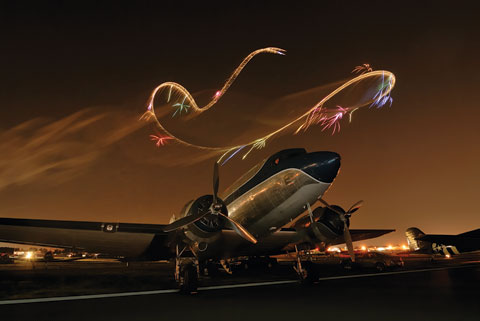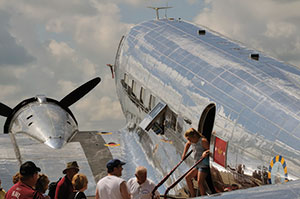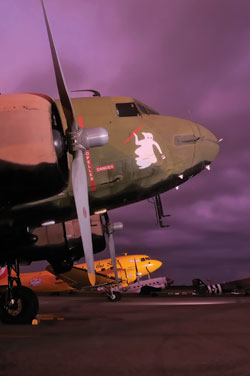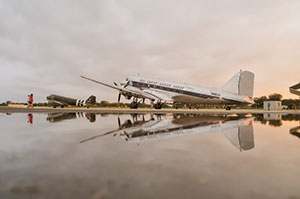A birthday to celebrate
Seventy-five years of the Douglas DC–3
How do you celebrate the seventy-fifth birthday of an airplane as iconic as the Douglas DC–3? Cake and ice cream doesn’t cut it—besides, that would be a lot of burning candles near fueled aircraft. How about some fireworks, maybe as part of a night airshow?

All that may be great for pilots, owners, and enthusiasts, but the airplanes might prefer a reunion fly-in where they can visit, catch up on the latest news—and fly. That’s exactly what they got from July 23 through 26 at Whiteside County Airport in Rock Falls, Illinois, with a DC–3/C–47 reunion dubbed “The Last Time.”
A marathon phone call between Donald Douglas and the president of American Airlines led to the development of the DC–3, described in Jane’s Encyclopedia of Aviation as “one of the world’s truly outstanding aeroplanes.” The carrier wanted an aircraft with sleeping berths that could be used for transcontinental service. But the fuselage of the 14-seat DC–2, which entered production in 1933 for TWA, was simply too small.
Construction of the first airframe began in December 1934, before a contract was finalized. The prototype DST—for Douglas Sleeper Transport—made its first flight on December 17, 1935, 32 years to the day after the Wright brothers’ historic first powered flight on North Carolina’s Outer Banks. Propelled by two nine-cylinder, 1,000-horsepower Wright Cyclone R-1820 engines, later versions had Cyclones—or Pratt & Whitney Twin Wasps—producing as much as 1,200 horsepower each.
 Capable of carrying 21 passengers in its initial configuration, and with performance eclipsing that of the competing Boeing 247, more than 400 DC–3s had been built before the United States entered World War II. Many were drafted into military service. When Douglas ended production in 1947, some 10,654 DC–3s, Army Air Corps C–47s, Navy R4Ds, and other variants had been produced—and several thousand more were built under license in other countries.
Capable of carrying 21 passengers in its initial configuration, and with performance eclipsing that of the competing Boeing 247, more than 400 DC–3s had been built before the United States entered World War II. Many were drafted into military service. When Douglas ended production in 1947, some 10,654 DC–3s, Army Air Corps C–47s, Navy R4Ds, and other variants had been produced—and several thousand more were built under license in other countries.
After the war many of those aircraft were sold as surplus and came to define the postwar airline industry. Today there are just over 500 DC–3s on the FAA registry. While they’re not all flying, many are still in commercial service, flying cargo, dropping skydivers, performing aerial application, or otherwise earning a living. However, as the airplane approaches the seventy-fifth anniversary of its first flight, an increasing proportion of the airworthy examples are operated by museums, organizations, or individuals intent on honoring the model’s history.
About 30 DC–3s—including many C–47 military transport versions, a C–41 military VIP transport, and a rare DC–2—gathered in Illinois the weekend before EAA AirVenture for The Last Time, billed as the last major reunion of DC–3 aluminum and engines—as well as the pilots who flew them, machinists who built them, and mechanics who maintained them. Thousands of people flocked to the airport to see the aircraft. Many were open for tours.
•••
One C–47, which had flown in the D-Day invasion of Europe during World War II, flew in from Texas—carrying one of the pilots who flew it during the war, and the family of another pilot. The late Don King flew C–47 serial number 42-32832, with the 53rd Troop Carrier Squadron, during Operation Overlord and Operation Neptune in the Allied invasion of France, as well as numerous paratrooper and supply missions in the European theater. Several members of King’s family made the trip. Also on board was Gerald Parker, a fellow pilot and longtime friend of King; the two flew that C–47 together before Parker was assigned his own aircraft.
 Scott Glover of Mount Pleasant, Texas, who owns the airplane, stopped at Love Field in Dallas to pick up King’s widow, son, and grandson. “When she saw that airplane at Love Field, she hadn’t seen it since she’d seen her husband take off for North Africa,” said Glover’s brother, Frank Glover. “It was an emotional little deal there on Love Field. If they’re a veteran from that era, they have a story to tell. This whole thing has been an experience of memories that we’ll never forget.”
Scott Glover of Mount Pleasant, Texas, who owns the airplane, stopped at Love Field in Dallas to pick up King’s widow, son, and grandson. “When she saw that airplane at Love Field, she hadn’t seen it since she’d seen her husband take off for North Africa,” said Glover’s brother, Frank Glover. “It was an emotional little deal there on Love Field. If they’re a veteran from that era, they have a story to tell. This whole thing has been an experience of memories that we’ll never forget.”
“I waved goodbye to it on May 3, 1943,” said Shirley King, who had never been in a DC–3 before—even though her husband flew them as a corporate pilot after the war. “I teared up when I got on the plane in Dallas,” she said, adding that her grandson had tears running down his cheeks, too.
Parker had not seen more than one or two C–47s together at one time since the war. “I had not been in one since 1944,” he said. After the war Parker became an air traffic controller and eventually worked to establish SIDs and STARs. “They don’t use the VORs,” he said, pointing toward a row of DC–3s. “They have a GPS.” Parker said King would be amazed that this airplane was still around. “I’m amazed that it’s still around,” he said.
Glover admits that he was not very interested in the airplane’s genealogy before acquiring the transport—but he’s now committed to uncovering as much of the airplane’s past as possible. “I’ve really gotten into the history of the airplane and its crews. I didn’t know it was a General Motors airplane, I didn’t know it was a D-Day airplane, until I started digging deeper,” Glover said.
The airplane sustained considerable combat damage during a mission King and Parker flew together on July 11, 1943—King’s twenty-third birthday. “This airplane was shot up pretty badly,” Parker recalled. “They patched it up and kept flying. And it’s still flying. You can’t see the patches—I checked where I knew there were holes.”
An antiaircraft tracer round penetrated the fuselage—and King’s parachute, missing him by inches. The round set the parachute on fire. King saved the parachute, and his family gave part of it to Glover in appreciation for his efforts in restoring the airplane.
•••
Another of the airplanes was built on October 17, 1938, and assigned to Gen. Henry H. “Hap” Arnold, the Army Air Corps chief of staff. (The military designated this C–47 airframe as a C–41, the only one of its kind.) After the war it saw a variety of uses, eventually flying tours around the San Francisco Bay for Otis Spunkmeyer Air. “When they found it, it was in pretty poor shape,” said Jim Gabbert, its current owner. “They spent a lot of money on it.”
 Gabbert bought the airline. “It wasn’t making money, but it was fun,” he said. (Its sister DC–3 from Spunkmeyer, N97H, is at the Hiller Aviation Museum in San Carlos, California, and was parked next door at the Illinois event.)
Gabbert bought the airline. “It wasn’t making money, but it was fun,” he said. (Its sister DC–3 from Spunkmeyer, N97H, is at the Hiller Aviation Museum in San Carlos, California, and was parked next door at the Illinois event.)
It took nine hours for the Oakland-based C–41 to fly to Illinois via Salt Lake City, which was a turbulent ride. “We should have gone by way of Albuquerque,” Gabbert said, adding that the flight home would take even longer because of headwinds. Long trips are nothing new for the airplane, which flew to Europe in 1994 for the commemoration of the Normandy invasion. Fuel burn for a DC–3 in cruise is about 100 gallons per hour.
What’s the secret to the airplane’s shiny finish? “We polished it about a year ago,” he said; a crew of three spent four or five days on the job. It’s kept in a hangar.
•••
When the Rock Falls event ended on July 26, 26 DC–3s took off for a formation flight to EAA AirVenture at Oshkosh. The incredible sound of 52 idling engines was surpassed only by the sight of the airplanes passing overhead, in flights of four. One returned to the ramp with a maintenance problem, another aborted its takeoff because of an engine issue, and a third returned with high oil temperature. The remaining 23 made a grand arrival in Oshkosh with an overhead pass.
While this seventy-fifth anniversary reunion was billed as “The Last Time,” don’t be surprised if there are multiple DC–3s flying on the airplane’s centennial in December 2035. While the design may be iconic, it also has durability—already demonstrated by its longevity.
E-mail the author at [email protected].


